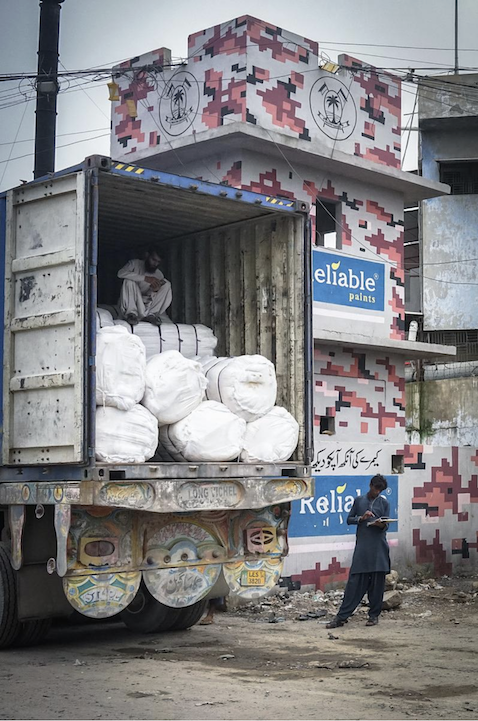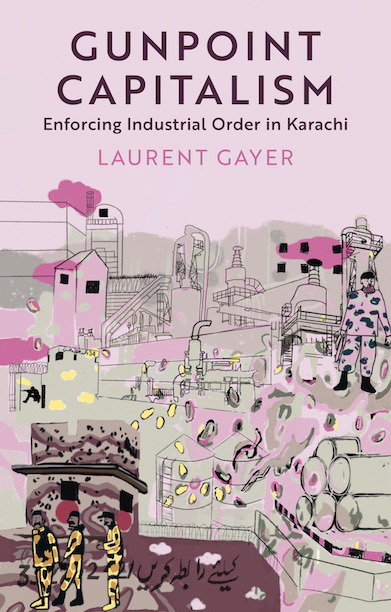Making economic order out of disorder: Insights from Karachi. Interview with Laurent Gayer

How can disorder produce order? What is the link between capitalism, globalisation and the private management of public order, and workers? In what ways is Karachi an interesting case study, and does it help us to understand the logic at work elsewhere? To mark the publication of his book Gunpoint Capitalism: Enforcing Industrial Order in Karachi (Hurst & Oxford University Press, 2025), Laurent Gayer answered our questions. He talks about his access to the field, his investigative work, and the evolution of capitalism in Karachi, Pakistan's industrial capital and, more broadly, its ongoing adaptation to globalisation, which sees bosses allying themselves with henchmen to enforce order and ensure profits.
Can you tell us about the industrial zones of Karachi, Pakistan, where you spent some time, and how you worked in an environment where you no doubt encountered a certain amount of resistance?
Karachi, now the economic and financial capital of Pakistan, was industrialised rather late. This port city was primarily a warehouse at the crossroads of the major regional trade routes until the creation of Pakistan in 1947. The industrialisation of the city proceeded apace during the 1950s and 1960s, notably around large industrial areas inspired by the Government Trading Estates developed in the United Kingdom in the 1930s—a prototype of public-private partnership based on the public development of infrastructure, the supply of turnkey factories, and the management of the area’s administrative affairs by a private limited company. Located on the outskirts of Karachi, these industrial zones have historically been organised around the textile industry, the flagship of the national economy and Pakistan's main source of foreign currency. Production has been diversifying since the 2000s, however, with the pharmaceutical industry, another sector I investigated between 2015 and 2022, particularly gaining ground.
 The industrial landscape varies from one area to another, but there are some recurring features, notably factories that look like prisons, echoed by the militarisation of the surrounding area. The factory walls are heightened with barbed wire and watchtowers, while armed guards stand watch in the crenelated towers painted in camouflage, along the main crossroads and roads. Despite this increased security, it is relatively easy to get to and around Karachi's industrial zones, at least when the monsoon rains and road traffic don't result in huge traffic jams. Generally speaking, I was able to investigate quite freely. While most of the managers I approached agreed to share their experiences, their address books, and certain documents, I was not allowed to enter the workshops except for short, closely supervised visits. No doubt the direct observation of production lines did not fit in well with my interviewees’ vision of academic research and, in their eyes, corresponded more to the specifications of external auditors, labour inspectors, and other troublemakers whose potential nuisance they were constantly and imaginatively trying to neutralise. I tried to overcome this obstacle by turning to other sources on the social relations of production and labour disputes: interviews with workers in the industry, labour court judgements, reports by British and American labour attachés, and autobiographical writings by union leaders.
The industrial landscape varies from one area to another, but there are some recurring features, notably factories that look like prisons, echoed by the militarisation of the surrounding area. The factory walls are heightened with barbed wire and watchtowers, while armed guards stand watch in the crenelated towers painted in camouflage, along the main crossroads and roads. Despite this increased security, it is relatively easy to get to and around Karachi's industrial zones, at least when the monsoon rains and road traffic don't result in huge traffic jams. Generally speaking, I was able to investigate quite freely. While most of the managers I approached agreed to share their experiences, their address books, and certain documents, I was not allowed to enter the workshops except for short, closely supervised visits. No doubt the direct observation of production lines did not fit in well with my interviewees’ vision of academic research and, in their eyes, corresponded more to the specifications of external auditors, labour inspectors, and other troublemakers whose potential nuisance they were constantly and imaginatively trying to neutralise. I tried to overcome this obstacle by turning to other sources on the social relations of production and labour disputes: interviews with workers in the industry, labour court judgements, reports by British and American labour attachés, and autobiographical writings by union leaders.
You mention the return of “predation” within capitalism. Can you tell us about this concept, its history, and its “comeback” in recent years?
The concept of predation has been used in a wide variety of ways by economists and social scientists. Among anthropologists, it refers to the appropriation, often by violent means, of the substance, identity, or energy of another being, whether human or non-human—a capture that contributes to what Philippe Descola calls “the socialisation of nature and others”. Recently, another anthropologist, Michel Naepels, has proposed revisiting the notion in order to “get to grips with capitalism's destructive power”, as close as possible to the forms of vulnerability engendered by the over-exploitation of man and nature. In a slightly different vein, heterodox economists such as James Galbraith have made this notion one of the central elements of their critique of neo-liberal capitalism. Drawing his inspiration from Thorstein Veblen , who saw predation as the hallmark of warriors and hunters who “reap where they have not sown” and who defend their status by “force or fraud”, Galbraith nonetheless makes a profoundly original use of the notion.
For him, predation is not the same as capturing rents or spoliation. Rather, it consists, for a coalition of corporate and political actors, in forming the state for themselves by appropriating its material and symbolic resources while paralysing it in the exercise of its regulatory functions. While James Galbraith had in mind the advent of a “corporate republic” in the United States under the two mandates of George W. Bush (2001-2009), the on-going offensive of Elon Musk and his “DOGE kids” against federal agencies and regulatory bodies provides another vivid illustration of this trend.
Even if this discussion has so far remained very American-centric, the Pakistani textile and clothing industry demonstrates that the phenomenon is not confined to the most industrialised societies. The companies that dominate this sector are at the head of the most powerful national lobby. They are masters in the art of capturing state subsidies while containing the state's attempts at control and, where necessary, neutralising its reforms. The successful integration of this industry into globalised fast-fashion circuits demonstrates that predatory logics are by no means archaic. On the contrary, they embody a contemporary modality of the processes of capitalist control and accumulation.
It is evident that the police are operating in the interests of corporate entities. They control workers and prevent social unrest. This securitisation process has the additional effect of authorising certain illegal and delinquent practices through legal channels, with the resources of the state being captured by predators. Could you please provide further information on this system, which unites the police and the owners of capital?
 The “mute compulsion” of the market, to use Marx’s terms, has not put an end to extra-economic coercion, any more than the claim by modern states to a monopoly on the legitimate use of force has entirely disarmed societies. The holders of capital—landowners, merchants, and industrialists—have retained means of physical coercion, in the form of militias, henchmen, or private police corps. In the context of capitalism, in its various forms—including agrarian, industrial, and extractive—a range of mercantile uses of force have emerged. The role of violent entrepreneurs, who serve the interests of corporate entities by specialising in the intimidation of workers and the repression of trade unions, is further compounded by the effects of the legal arsenal at their disposal.
The “mute compulsion” of the market, to use Marx’s terms, has not put an end to extra-economic coercion, any more than the claim by modern states to a monopoly on the legitimate use of force has entirely disarmed societies. The holders of capital—landowners, merchants, and industrialists—have retained means of physical coercion, in the form of militias, henchmen, or private police corps. In the context of capitalism, in its various forms—including agrarian, industrial, and extractive—a range of mercantile uses of force have emerged. The role of violent entrepreneurs, who serve the interests of corporate entities by specialising in the intimidation of workers and the repression of trade unions, is further compounded by the effects of the legal arsenal at their disposal.
The coercive apparatus of the state, comprising the army, the police, and the judiciary, offers inexhaustible resources for containing social struggles. A myriad of intimidation tactics, both legal and extra-legal, are available through the interpretation of the law. Finally, there is what Michel Foucault calls the “differential management of illegalisms”: the differentiated treatment by the repressive state apparatus of deviations from the law by the working and wealthy classes. The case of Karachi is particularly illuminating in this regard, because it exposes a broad spectrum of collusion among the owners of capital, specialists in coercion, law enforcement, the military, paramilitaries, thugs, and militants of various kinds. However, these collusions have never culminated in a lasting alliance between capital and coercion. This repressive configuration is founded on an unstable balance of forces in constant fluctuation. This book traces the turbulent history of this relationship of suspicious intimacy between the virtuosos of violence and the owners of capital.
Can you also explain how capitalism can develop in such a violent and unpredictable environment?
A pervasive enigma that runs through the book is that of a dynamic industrial economy, growing steadily despite a state of chronic disorder. For a period of three decades, from 1985 to around 2015, Karachi was beset by deadly conflicts, which had a particularly disruptive effect on the local economy as a result of it being directly targeted. The days of “general strike” regularly declared by opposing forces were intended to secure political concessions by holding the economy hostage. The abduction of industrialists and the extortion associated with this period also contributed to the creation of an insecure environment, which at first sight was not conducive to commercial activity.
Karachi’s industrialists, however, have come to terms with the prevailing disorder. They have learned to protect themselves from it, or at least to minimise the cost. In a more original way, they have forged fruitful partnerships with the forces of disorder, mobilising the coercive resources of political parties, gangs, and jihadist groups to discipline the workforce and impose increasingly precarious and authoritarian working relationships. They have also used these relationships to gain access to certain illicit economic rents controlled by the belligerents, such as the parallel water and electricity markets. These fruitful relationships between forces of disorder and productive actors call for a reconsideration of the idea that capitalism necessarily needs peace and order to prosper.

Are there progressive entrepreneurs? Can we talk about progressive entrepreneurs?
My first entry points, as far as Karachi's business community is concerned, were entrepreneurs with progressive credentials, a significant proportion of whom had been influenced by the protest movements of the 1960s and 1970s. Originating from the student left or underground communist movements, these employers cultivated their distinctiveness by offering superior remuneration and advocating for working relationships that were less overtly oppressive than those prevalent in the broader industry. However, these industrialists share with the rest of the employers a virulent anti-union stance and an attachment to flexible employment, so as to retain the possibility of dismissing without further ado any worker suspected of politicisation. The conflicts of recent decades have engendered a pervasive distrust of union representatives and politicised workers among industrialists, who fear that the former will utilise their political resources to extort their employers, foment disorder, and, more generally, give in to their natural inclination for idleness.
There was a trial in Germany after the fire in 2012 at Ali Enterprises in the textile industry zone of Karachi, a disaster that killed 255 people and which you talk about in your book. As a result of this trial, a new law was passed that came into force in 2023. Can you tell us a little about it?
The Ali Enterprises trial, which provides the narrative framework for the book, is in a way the trial of the globalised economy and its pseudo-regime of regulation. This company mainly manufactured jeans for the German discount retailer KiK and had just been awarded an SA 8000 certificate of compliance with various international safety and labour law standards, standards which, as the investigation soon showed, were in fact blithely flouted by the factory's owners. Although KiK eventually compensated the families of the victims, its responsibility could not be established before the German courts. This industrial fire—the deadliest in world history—nonetheless had a considerable impact in Germany and precipitated the adoption of legislation on due diligence owed by buyers to their suppliers.
The German law adopted in 2021, which came into force on 1 January 2023, is significantly different from the pioneering legislation adopted in this area by France in 2017. It relies less on the judicial tool and more on a control apparatus and options for bureaucratic recourse, extended to workers throughout the supply chains. Despite these differences, this is a new step toward a coercive system for regulating global value chains, pending a possible European directive. The mobilisation of citizens and NGOs defending the principle of due diligence for multinational companies is beginning to bear fruit. The book closes on this opening up of possibilities, in terms of the defence of workers' rights and the convergence of struggles on an international scale.
Finally, in your book you talk about the effects of Covid on Karachi's textile industry, mentioning in particular the feminisation of the workforce, something new for Pakistan. What consequences might this have?
Karachi's industrialists—and those of Pakistan in general—are masters in the art of navigating troubled waters. They have weathered political, economic, and health crises by managing, each time, to limit the damage, for their companies at least. Quite often, they have also taken advantage of the prevailing tumult to impose new working relationships and explore new ways of circumventing, neutralising, or exploiting the legal framework.
During the Covid epidemic, they took advantage of state subsidies while at the same time resorting to massive redundancies, in complete contradiction to their commitments. In many companies, these redundancies led to a change in the workforce profile, with more women being employed. For cultural reasons, Pakistani industry—starting with the clothing sector— remains relatively unfeminised, in contrast to other Asian countries (Thailand, Cambodia, Vietnam, and even Bangladesh). The massive redundancies justified by Covid have enabled many companies to shed their male workers in favour of female workers who are perceived as more meticulous but also more docile and more willing to accept lower pay for equal work. These expectations are likely to be disappointed: throughout my investigation, I kept meeting women workers determined to defend their rights and dignity against delinquent elites and their thugs.
Interview by Corinne Deloy
Cover photo: Employee of a private security company posted in front of a textile factory in the Sindh Industrial Trading Estate (SITE). Photo Laurent Gayer, 2022.
Photo 1: Sindh Rangers Chowki (watchtower) in front of the Liberty Mills textile factory, SITE (2016).
Photo 2: Cover of the book.
Photo 3: Working-class family crossing one of the main roads in the Korangi industrial zone. Photo credit: Laurent Gayer, 2015.
Photo 4: Rangers Security Guards (RSG) check point close to the Zia Colony neighbourhood. Photo credit: Laurent Gayer, 2022.
Explore more photos by Laurent Gayer on his website:
Géographies du capital : le paysage industriel de Karachi










